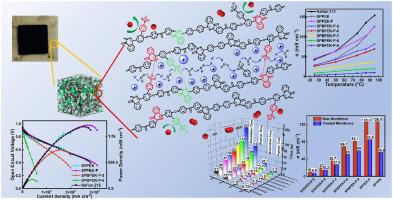Advanced proton exchange membrane prepared from N-heterocyclic poly(aryl ether ketone)s with pendant benzenesulfonic moieties and performing enhanced radical tolerance and fuel cell properties
Abstract
The application of sulfonated poly(aryl ether)s proton exchange membranes in fuel cells is hampered by the inadequate oxidation stability and the trade-off effect between proton-conducting performance and physicochemical stability. So the sulfonated N-heterocyclic poly(aryl ether ketone)s (SPBPEK-Ps) membranes possessing fine proton-conducting behavior and radical tolerance are manufactured by the elaborate design of molecular backbones. The hydrophilic units containing proton-conducting groups in pendant moieties in SPBPEK-Ps contribute to constructing developed proton-conducting channels, in which the multiple interactions between sulfonic groups and N-heterocycles further promote proton conduction with the conductivity of up to 125 mS cm−1. The fuel cells loading SPBPEK-Ps membranes perform a power density of up to 1210 mW cm−2 with hypo-sensitivity to temperature and oxidized gas. A couple of steric hindrances from pendant proton-conducting groups and the diminished affinity of radicals for molecular chains resulting from the introduction of N-heterocyclic structure enhance the oxidation stability of SPBPEK-Ps membranes, and the break time of the membranes at 80 °C ranges in 2.5–7.8 h. The combination of the pendant proton-conducting groups and N-heterocycles with the electron-withdrawing effect would contribute to improving proton-conducting performance and oxidation stability and attenuating the trade-off effect between them.


 求助内容:
求助内容: 应助结果提醒方式:
应助结果提醒方式:


